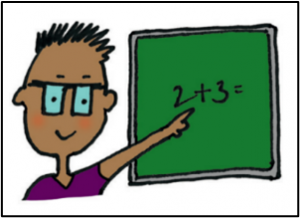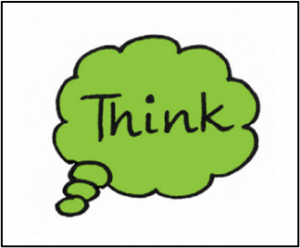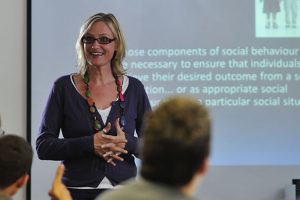What’s in this issue of Alex’s Talkabout Tips?
For those of you who read my last blog you will know that I am currently talking about what you need to do to get started. Last issue was a bit of a ‘headlines’ issue… so we are now going to think about these in a bit more detail. And in this blog, I am going to go back to the basics and briefly tackle the theory that underpins any social skills intervention.
As I said in the last issue – the first thing you want to think about is what you want to achieve. Do you have a long-term vision for social skills work in your place of work? And if so, how can you get there? Some schools I work with want to go big and have a long-term plan to have Talkabout on the curriculum for all children. They may want all children to progress through the stages of Talkabout so that in the first year they do sessions on self-awareness and self-esteem, in the second year they cover body language, the third year, conversations, and so on. Or you may have a vision for someone you are working with, where they develop effective relationship skills or assertiveness. But in all of these cases, you know that you can’t get them there immediately. And as I said last time, you need to understand some of the theory to understand this. To understand why.
So, what’s the theory in a nutshell?
 It is helpful to start by looking at what social skills are. What do we mean by being socially skilled? If you go back to my first blog, I talked about this and how we can define it.
It is helpful to start by looking at what social skills are. What do we mean by being socially skilled? If you go back to my first blog, I talked about this and how we can define it.
I described the 7 components to defining social skills which were:
The 7 components to defining social skills
1. Social skills enable us to achieve our desired outcome – our socially skilled behaviours are ‘goal directed’ – so if I want you to carry on talking to me, I will use purposeful behaviours to encourage you – I will look at you, nod my head, use listening noises etc.
2. Social skills include nonverbal and verbal behaviours – body language, the way we talk, and conversational skills.
3. Socially skilled behaviours are interrelated – we use several behaviours at a time.
4. Social skills are learned behaviours – through imitation, modelling, and reinforcement.
5. Social skills should be appropriate to the situation – so we need to learn the behaviours and then learn to use them in a way that is acceptable to the other person and the context.
6. Socially skilled people know when to talk, what to say and how to say it.
7. A socially skilled person reads their audience and shapes their responses – so we learn to read the other person to work out what they are thinking so that we can adapt our responses accordingly.
So in this issue I want to expand on these ‘behaviours’ that are mentioned.
A summary of social skills or our social ‘behaviours’
Social skills can be divided into our nonverbal behaviours and our verbal behaviours. And by nonverbal, I mean body language and paralanguage (or the way we talk), and by verbal behaviour, I mean conversational skills. And then there are assertiveness skills.
Our body language is made up of 8 primary behaviours:
 Eye contact
Eye contact- Facial expression
- Gesture / use of hands
- Distance /proximity
- Touch
- Fidgeting
- Posture
- Personal appearance
Our paralinguistic skills (or the way we talk) are made up of 5 primary behaviours:
Our conversational skills are made up of 8 primary behaviours:
- Listening

- Starting a conversation
- Taking turns
- Asking questions
- Answering questions
- Being relevant
- Repairing
- Ending a conversation
And our assertiveness skills are made up of 8 primary behaviours:
- Expressing feelings

- Standing up for yourself
- Making suggestions
- Refusing
- Disagreeing
- Complaining
- Apologising
- Requesting explanations
So if these 29 behaviours are the behaviours that we use at different times and in different ways to be ‘socially competent’, then these are the behaviours that we will need to assess and then teach, if appropriate to do so.
But where do you start?
 And is there a right (and wrong) place to start?
And is there a right (and wrong) place to start?
These were the questions that I found myself asking 30 years ago when I was working in a further education college with young adults with an intellectual disability. So, I set out to answer this question and to try to work out what interventions worked best.
I started by assessing all 60 students and then dividing them into their main area of need and working on these needs over the academic year. So, I had groups that focused on body language (nonverbal skills), conversations (verbal skills), and assertiveness skills. But I also had groups that worked on increasing awareness of communication, as some students had a poor awareness of this.
At the end of the year, I evaluated success through re-assessment, and here I noticed a pattern:
- Students in any of the conversational skills groups progressed more if they had good existing nonverbal skills
- Students in any of the assertiveness groups progressed more if they had good existing nonverbal and verbal skills
- And students who had poor self / other awareness struggled with all aspects of social skills.
So what I was beginning to see was a hierarchy of intervention that meant that the success of my work increased if I taught self-awareness first, and then nonverbal behaviours were taught prior to verbal behaviours, and assertiveness was taught last. In addition, I found that self-esteem should be developed alongside self-awareness and that friendship skills should be taught after social skills. I tested this theory out over the next few years, and the results were always the same. So, if we spend time developing the foundation skills of self-esteem and self-awareness and then concentrate on body language prior to the more complex areas of conversational skills, friendship skills and assertiveness, we are more likely to see progress.
 This is logical. And it is the difference between setting someone up to succeed or to fail. Think about conversational skills; they are more complex than the nonverbal behaviours. For example, consider the skill of being able to listen in a conversation: a good listener uses appropriate eye contact and facial expression to show he is listening. Now consider turn taking… this needs good listening which in turns needs eye contact etc. So, choosing the wrong skill to start work on, i.e. a skill that is too complex, will potentially set someone up to fail.
This is logical. And it is the difference between setting someone up to succeed or to fail. Think about conversational skills; they are more complex than the nonverbal behaviours. For example, consider the skill of being able to listen in a conversation: a good listener uses appropriate eye contact and facial expression to show he is listening. Now consider turn taking… this needs good listening which in turns needs eye contact etc. So, choosing the wrong skill to start work on, i.e. a skill that is too complex, will potentially set someone up to fail.
And this is how Talkabout was first developed. I wrote a programme for the FE college where I was working, that taught skills from self-awareness to assertiveness. And then because of it’s success, it was then piloted in other settings by other clinicians over a period of 4 years, before it was considered for publication.
And this is what I mean by the hierarchical method of intervention. It means that we develop skills ideally in the following order…
![]() 1. Self-awareness & self-esteem
1. Self-awareness & self-esteem
2. Nonverbal behaviours (Body language & the way we talk)
3. Verbal behaviours (Conversational skills)
4. Friendship skills (Making & maintaining friendships)
5. Assertiveness
This is important to know when setting out your vision for your school or place of work. You may want everyone to learn how to be assertive or to develop their friendship skills, but if those students don’t have the underpinning skills necessary to develop those more complex skills, then your vision is flawed, and you may be in trouble.
In summary…
I hope that has helped you to understand the theory a bit more. You can read more about this in my book ‘Social Skills: developing effective interpersonal communication’(Kelly, 2019).
In the next issue I will look at how we can assess people so that we can then know where to start.
Please do comment on Facebook or share this with others. If you would like to be added to my email distribution list, please contact me through the website, email me directly or PM me.
Thanks for reading!
alex@alexkelly.biz
SHARE via FB / twitter







